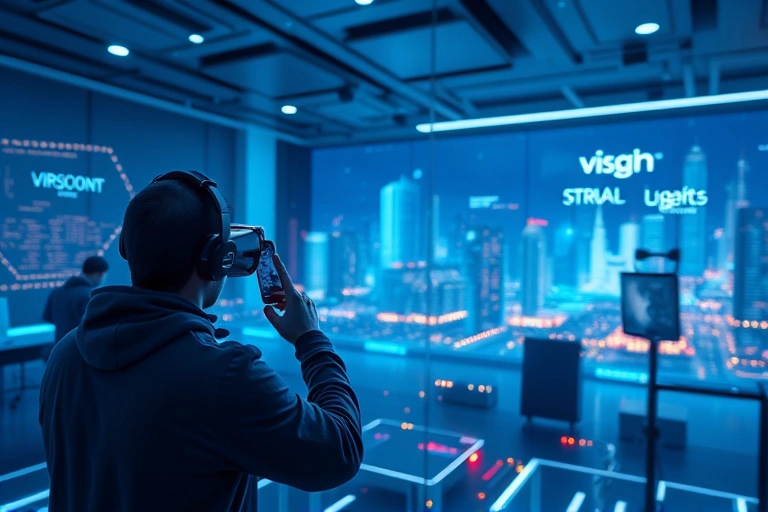VR Cloud Streaming Revolution 2025: How 5G Makes Virtual Reality Accessible to Everyone
Introduction
The landscape of technology is ever-evolving, and with the advent of 5G networks, we are on the brink of a revolution in virtual reality (VR). As we move towards 2025, the integration of VR cloud streaming with robust 5G infrastructure promises to make virtual reality accessible to a broader audience than ever before. This article explores the impact of 5G on VR, the implications of VR cloud streaming, and the future trends that will define the accessibility of immersive experiences.

Main Development
At its core, the intersection of 5G and virtual reality represents a breakthrough in how we experience digital content. Traditional VR setups often require powerful hardware and complex installations, limiting access to a select group of users. However, with VR cloud streaming, the heavy lifting is done in the cloud, allowing users to engage with rich VR environments through lightweight devices.
The impact of 5G on VR is multi-faceted. 5G technology offers significantly higher bandwidth, reduced latency, and improved connectivity. These advancements enable real-time data transmission, which is essential for delivering high-quality VR experiences. Users can expect seamless interactions, high-resolution visuals, and immersive soundscapes without the lag that has historically plagued online gaming and VR experiences.
Moreover, as we approach 2025, we can anticipate a surge in 2025 VR trends that will further enhance accessibility. With cloud gaming revolutionizing not just video games, but also VR applications, users will find themselves able to access a myriad of experiences without the need for expensive hardware. This democratization of technology will expand the audience for VR, making it a mainstream medium for entertainment, education, and training.
🎥 Related video: VR Cloud Streaming Revolution 2025: How 5G Makes Virtual Reality Accessible to Everyone
Analysis and Benefits
The analysis of virtual reality accessibility through 5G and cloud streaming reveals several key benefits. Firstly, the reduction in hardware requirements lowers the cost barrier for entry into the VR space. Users can connect to VR experiences via smartphones, tablets, or even smart glasses, which are significantly more affordable than traditional VR headsets.
Secondly, the enhanced performance provided by 5G networks ensures that users can enjoy high-fidelity experiences without interruption. This reliability is crucial for applications ranging from gaming to virtual meetings and online education. The immersive nature of VR hinges on the ability to engage users fully, and any delay or disruption can detract from that experience.
Furthermore, the rise of accessible VR technology encourages the development of content tailored to diverse audiences, including those with disabilities. Developers are increasingly recognizing the importance of inclusivity, and with VR cloud streaming, they can create experiences that cater to a wider range of users. This may include adaptive controls or environments designed to accommodate various physical abilities.
- Wider Audience Reach: 5G technology makes VR available to more users, regardless of their location.
- Cost-Effective Solutions: Users can engage with VR without investing in high-end hardware.
- Enhanced Content Creation: Developers can innovate freely, knowing that the cloud can handle processing demands.
- Inclusion: More accessible VR experiences cater to users with different needs and preferences.
Practical Implementation
Implementing VR cloud streaming with 5G requires a strategic approach. First and foremost, content creators and developers need to leverage the capabilities of cloud computing to deliver high-quality experiences. This involves utilizing powerful servers with advanced GPUs capable of rendering VR content efficiently.
Furthermore, telecommunications companies must continue to invest in expanding their 5G networks to ensure that coverage is widespread. As more users gain access to 5G technology, the potential for VR applications will only grow. Partnerships between tech companies and network providers will be essential in fostering an ecosystem that supports seamless VR engagement.
In addition to infrastructure, user education is vital. As VR becomes more accessible, users must be informed about how to engage with these technologies effectively. Tutorials, community forums, and user-friendly interfaces will help bridge the gap between technology and the average consumer. The goal is to create an environment where users can easily jump into immersive experiences without technical hurdles.
- Invest in Infrastructure: Telecommunications companies should expand their 5G coverage.
- Develop Robust Content: Content creators must focus on cloud-optimized VR applications.
- Educate Users: Provide resources for users to understand and navigate VR technologies.
- Foster Collaboration: Partnerships between tech companies will enhance the VR ecosystem.

Frequently Asked Questions
What is VR cloud streaming?
VR cloud streaming refers to the delivery of virtual reality content over the internet, allowing users to access VR experiences without the need for powerful local hardware. Instead, the processing happens in the cloud, and users can stream content to their devices.
How does 5G improve VR experiences?
5G technology provides higher bandwidth and lower latency, which are crucial for real-time VR interactions. This means smoother, more responsive experiences, enabling users to engage fully with virtual environments.
What are some examples of accessible VR technology?
Accessible VR technology includes platforms that allow users to participate in virtual experiences using a variety of devices, including smartphones, tablets, and adaptive controllers designed for people with disabilities.
What trends should we expect in VR by 2025?
By 2025, we can expect trends such as increased integration of VR in education and training, the growth of social VR platforms, and a surge in content tailored for diverse audiences. Additionally, we will likely see enhanced collaboration tools for remote work.
How can individuals participate in the VR cloud streaming revolution?
Individuals can participate by staying informed about advances in 5G technology, exploring VR apps available on their devices, and advocating for inclusive content. As VR becomes more mainstream, everyone can find a way to engage with this transformative technology.
Conclusion
The fusion of 5G virtual reality and VR cloud streaming stands to revolutionize how we perceive and interact with digital content. As we approach 2025, the accessibility of VR technology will expand dramatically, allowing a more diverse audience to enjoy immersive experiences. By breaking down barriers related to hardware, cost, and accessibility, we are paving the way for a future where virtual reality is a staple in everyday life, from gaming to education. This evolution not only enhances entertainment but also fosters inclusivity, ensuring that everyone can participate in the virtual world.







